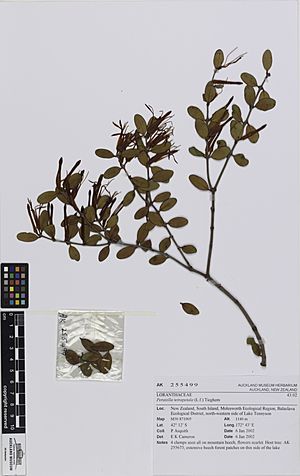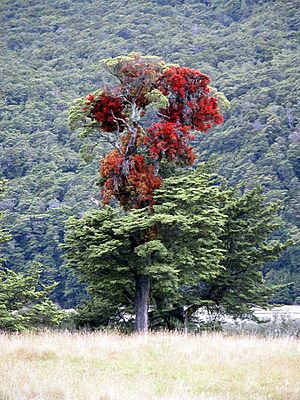Red mistletoe facts for kids
Quick facts for kids Red mistletoe |
|
|---|---|
 |
|
| Conservation status | |
 Gradual Decline (NZ TCS) |
|
| Scientific classification | |
| Genus: |
Peraxilla
|
| Species: |
tetrapetala
|
Red mistletoe (its scientific name is Peraxilla tetrapetala) is a special plant that grows in New Zealand. It's called 'red mistletoe' because of its bright flowers. This plant is endemic to New Zealand, meaning it's found nowhere else in the world. You can find it on both the North and South Islands. The Māori names for this plant are pikirangi, pirirangi, and roeroe.
Red mistletoe is a parasitic plant. This means it lives on other plants, called 'host plants', and gets its water and nutrients from them. It grows as a shrub, usually up to one meter tall. Its leaves are smooth, and its flowers are bright red to orange. These flowers are about 4–5 millimeters long and split open all the way to the bottom.
Red mistletoe mostly grows on beech trees, especially the black or mountain beech. However, in some northern areas, it can also be found on other trees like tawheowheo, pohutukawa, puriri, and towai. This makes it the most widespread type of mistletoe that grows on beech trees.
How Red Mistletoe Reproduces
Red mistletoe can reproduce on its own. It has both male and female parts in the same flower. Birds are very important for this plant's life cycle. They help to pollinate the flowers, which means they carry pollen from one flower to another. Birds also help to spread the seeds.
When the flower buds open, they do so with a small "explosion"! Even though birds help with pollination, they are even more important for spreading the seeds to new places.
The caterpillar of a special moth called Zelleria maculata also interacts with red mistletoe. This moth is also endemic to New Zealand. Its caterpillars feed inside the flower buds of the red mistletoe.
Conservation of Red Mistletoe
Red mistletoe faces some threats that make it harder for the plant to survive. One big problem is an animal called the common brushtail possum, which was brought to New Zealand. Possums really like to eat red mistletoe.
Possums cause more damage to red mistletoe in the North Island. In the South Island, insects are a bigger reason why the plant's leaves get eaten. Another major threat to red mistletoe is the loss of its natural habitat, which means the places where it grows are being destroyed.
Because of these threats, red mistletoe is listed as being in "Gradual Decline" by the New Zealand Threat Classification System. This means it needs help and special conservation efforts to stop its numbers from going down.


